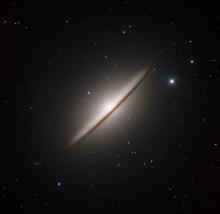Listen to today's episode of StarDate on the web the same day it airs in high-quality streaming audio without any extra ads or announcements. Choose a $8 one-month pass, or listen every day for a year for just $30.
You are here
Looking for Wormholes
Science fiction loves wormholes. These “shortcuts” through space and time might allow a ship to enter one end and quickly exit on the other side of the universe — or even a different universe.
Wormholes don’t violate the laws of physics, but no one has ever seen evidence of them. But there might be a way to find one: by watching a black hole come through one.
A study last year found that a black hole spiraling into a heavier wormhole would produce gravitational waves — ripples in space and time. Special detectors have already used gravitational waves to discover the mergers of black holes. Such a merger produces a sort of “chirp” as the black holes spiral together.
The study showed that a black hole could enter a wormhole, pass through it, and exit into another universe. The exit would also produce gravitational waves. Instead of a chirp, though, detectors would hear an anti-chirp.
The black hole might pass through the wormhole again and again, producing bursts of waves each time. Eventually, the waves could carry away so much energy that the black hole would settle down in the wormhole, and the chirps would end.
Scientists are sifting through old observations to see if they can find any such encounters. And they’ll look even more closely when upgraded instruments return to service next year — for evidence of cosmic shortcuts.
More about gravitational waves tomorrow.
Script by Damond Benningfield





